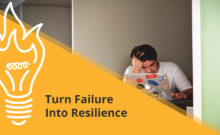I love entrepreneurs. The passion for their company, the new and exciting possibilities, their love of their business, the pitching, the scaling, “new company” smell. I love it all. I could not ask for a better job but to work with entrepreneurs across the world and in all different industries to help them tell their story through a compelling and effective pitch deck. It’s the perfect combination of art and science, design and business, right brain and left brain. And, as I’ve worked with entrepreneurs from all walks of life, different ages, different genres, different backgrounds, different skill sets, different personalities… one things is consistent across all of our clients, and I venture to guess all entrepreneurs: they all have a “one thing.”
That “one thing” that they just can’t let go of, that they think is important about their business that really isn’t. They hold on to this “one thing” so tightly, that it’s hard–if not impossible–to pry it from their fingers. And when you get to know a business as intimately as a pitch deck designer needs to get to know a business, you always find it. That “one thing.” It’s caused by founders disease, a scary, possibly confrontational sounding term that has been used with all manner of connotations to refer to when a founder cannot see past something in his/her business. The disease of being the founder, of it being their baby, of their passion for the company, and strong mindedness has blinded them to the fact that this “one thing” is no longer serving them or the company.
Common “One Things” That We’ve Seen
Stuck On a Logo
This is a big one. One of the most common. Especially when the founder was the one who designed the logo several years/months ago. Logos can be a hard thing to get right. They need to be abstract enough that you can use them over and over again in all different formats. They need to convey your company ethos, and give the viewer an idea of what your company does. And, they need to be visually appealing and clear. Sometimes they have your company name and tagline, sometimes they don’t. Sometimes they are monotone, other times they are full of color. What matters most is that they are unique, usable and visually appealing. Usually this requires a logo to be abstract, (think apple’s logo of an apple vs. a picture of an apple, the abstraction of apple’s apple is the right direction to go). When a founder tries to put together a logo themselves without a design background, the logo tends to be a stock image (not a logo) a stock icon (not a logo) and in general look old, outdated, or cobbled together. Essentially less professional. This can be a “one thing” for founders who have a strong attachment to their logo for some reason or another. They cannot see past their own love of the logo and their own knowledge of it’s meaning when customers and investors (the people that matter) don’t get it or aren’t drawn to it in the same way. A bad logo will not only push customers and investors away, but it’s negative effects are pervasive throughout your brand and messaging. Bad logos mean bad website, and leave designers of any marketing collateral or pitch deck stranded. This leaves you with less consistent and cohesive collateral overall. It’s a bad cycle. If you put together your logo, or it is not custom developed, this is definitely you.
Stuck On the Features
Many startups are founded by a developer or engineer who had an interesting idea for a new product. The technician. He or she knows their industry well, they saw a problem and said, “hey! I know how to fix that!” And they did. By the time they start working with us, they have poured their heart and soul into building the product. They remember every late night fixing bugs in the code, every eureka moment to ensure that the product does what it says it will do, every single feature that they have decided to include. And, when it comes time to put together the pitch deck, their “one thing” is to get stuck on all of their cool features. This button does this, and that part does that, and this other thing here, well, people are going to love it because it does this very specific but helpful task. Those are all fine and good. And while it is true that a product is usually made up of a series of features & functions, it is not true that a company is made up of features. The pitch deck is selling the company not the product. So very often our team butts heads with entrepreneurs who want to go into excruciating detail on the features of their product in the pitch, when in reality your investor wants to know how those features benefit the customer, why the customer will buy it, and how your company is going to grow and be profitable because of it. If you see yourself wanting to demo every aspect of your tool to everyone, or requesting that 17 different screenshots go into your pitch deck, this is you.
Stuck On Your Own Story
Entrepreneurship is a journey. A long and sometimes bumpy one for many founders. You very likely have changed major parts of your idea, vision or execution of your company along the way. Some pivots are more drastic than others, and often times these pivots involve deeply personal reasons. While it is important to “tell your story” and talk to “why” you started your company in the first place, there is a limit to how much and how detailed that story should be. I have seen many pitches where the entrepreneur does not strike this balance well. Instead they spend far too long talking about the ups and downs of their business. They tell about all of the pivots no matter how long ago, “well first we were an app for this, they we realized people needed this other service, then we decided a service company was hard to scale so we built this platform, then because another user base started using the app we needed to shift our message and marketing focus, then we changed the name and now…” It’s too much. This founder confuses the audience, wastes time and worst of all, makes the company seem like it has a shaky foundation and lack of direction. Telling the full story of why you finally decided on the business model or customer group, is not necessarily important, and it is many entrepreneurs’ “one thing” as they move from ideation to growth and investment. Stories should be shortened and simplified. Parts of the origin story that distract from the current company trajectory should be omitted altogether. It may be a big part of your life, but that does not mean it matters to your investors when making a decision on whether your business is a good investment. If you find yourself explaining shifts that your business did years ago in casual conversation, this is you.
Stuck On Your Own Koolaid
To succeed in the long haul of starting a company, you have to be optimistic. Many many many companies fail, and to believe wholeheartedly that your business will not be one of them, is pure optimism, and a little faith. With so many signs pointing towards the opposite, how do founders fight off the seeds of doubt and keep building? An optimistic attitude, and hopefully a lot of research, customer validation, and planning for the worst possible outcomes (just in case). Many entrepreneurs’ “one thing” is an unbridled form of this optimism, they are drinking their own optimism koolaid. Without knowing your numbers, without understanding your market, without talking to your customers to confirm your hypotheses, that optimism is just wishful thinking and crossing fingers. If you tell me when we start a pitch deck project “Stacie, I don’t have any competitors,” I’ll tell you you’re wrong. All companies have a competitor, in fact several. If there is a true problem in the world that you are solving, your customers are using SOMETHING to solve it today. Even if that something is terrible, free, or not made to solve the problem directly. Another place this often crops up is in the go to market strategy. If your go to market strategy is “I’ll just market it,” you’re in trouble. How are you going to market it? What is it going to cost / how long will it take? How many customers will that effort acquire? Do you have key relationships with partners with large audiences or some feature of your business that make it easier for customers to find out about you through existing customers and reduce your acquisition costs? If you think you’ll just build this thing and people will crawl out of the woodwork to give you money, you have been drinking your own koolaid a little too much.
Best Ways to Combat Founders Disease
It’s hard to see founders disease in your own business. And the thing is, you DO have founders disease. It’s somewhere. It’s in there. You’re stuck on something. You have a “one thing.” The good thing is you can root it out and you can make it better.
Spend the time to be reflective on your business. As the founder or owner, or upper level management, it is your job to think big-picture. You need to step back from your day-to-day tasks and take a strategic forward-thinking approach to your business. Think about where you want to go, and what it might take to get there. Think about areas where you have competition and what they are doing better than you. Think about areas where you don’t have product offerings, or customers that you don’t target, but could. What would matter to them? Look internally at your company and yourself and ask “What could be better? Faster? Smoother? Easier? Cheaper?” If you find yourself hesitating on any change, ask yourself “why?” This is a prime place where your “one thing” will crop up. Are you afraid to write down the process for how you do something because “no one else can do it but you?” Maybe that’s your “one thing” Your company is a living breathing thing that exists outside of you. You need to listen to the market forces, the customers, and the employees of that organism and do what you need to to make it run the best that it can run. Your “one thing” is just holding you back. Let it go, move on, make it better, and stay focused on the task and goals at hand.
If you’re having trouble working with an outside expert can always help. Be open to what your pitch deck designer says. Consider it’s validity from many angles. Be open to changing your logo, your story, focusing on the company instead of the product, and make sure you have what you need to back up that awesome optimism that you have. You need it, you just need to keep it in check.
So what’s your “one thing”? And what are you going to do about it?







